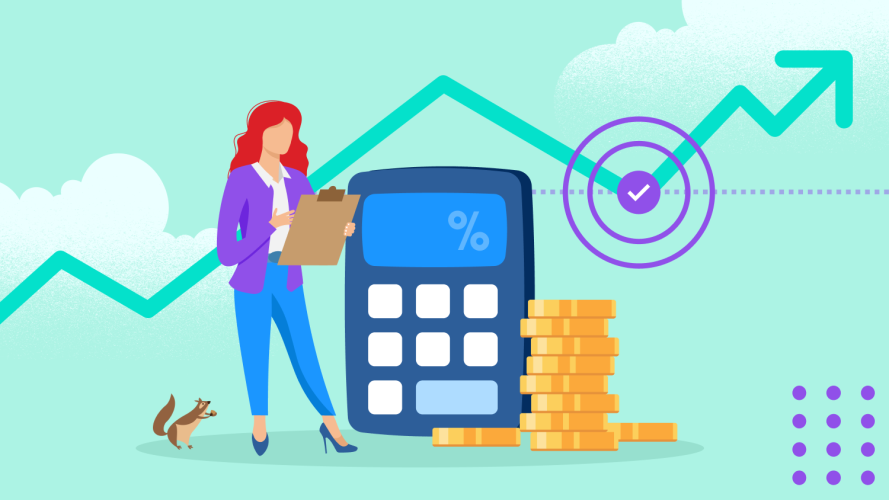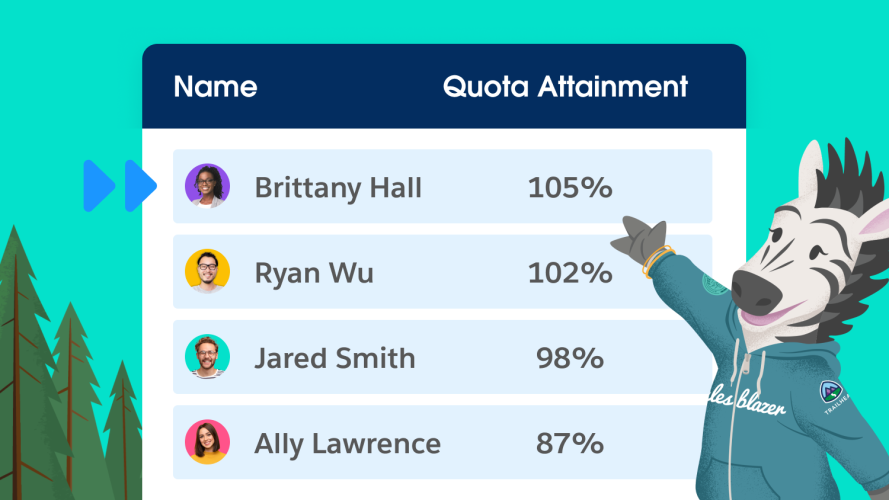4 Sales Email Templates to Get Better Open Rates

Crafting the perfect sales email doesn't have to take hours — it just take the right elements.

Donald Kelly
You’ve done your research. You feel like you’ve got a firm grasp on your prospect and their pain points. You sit down to write an email that perfectly outlines how you can help them meet their goals, and you hit “send.” Days go by, and you hear nothing but crickets.
Getting ghosted by prospects can be one of the most disheartening parts of a seller’s job. But it doesn’t have to be that way. Below, we share a vetted sales email template that can help you get responses.
What you’ll learn
- What is a sales email template?
- Elements of an effective sales email
- When to use a sales email template
- 4 sales email templates and why they work
- Sales email template best practices
A new way to go from lead to close
Harness CRM data outside the CRM with Sales Engagement, and engage buyers as they move across the web.



What is a sales email template?
A sales email template is a pre-written message, sent via email, that can be quickly and easily customized for different audiences. A collection of sales email templates — each one designed for a different type of outreach — is the backbone of your sales outreach, giving you an outline of a conversation that you can tweak for each prospect.
Elements of an effective sales email
There are four core components in an effective sales email template. They ensure your emails are balanced, easy to read, and memorable. Let’s break them down:
- Greeting. Start with a simple greeting using the prospect’s first name. This helps you make your message more inviting and personalized.
- Simple, low-stakes question. The goal of your outreach is not to ask for an appointment or make a sale right away. You haven’t established enough value in the first few engagements for that to happen. Instead, you want to ask a simple, low-stakes question that starts a conversation based on their interests and needs. For example, asking “Do you currently use a service like this?” or “Do you partner with outside organizations?” allows your prospect to write back with a simple “No, but I’m interested,” or “Yes we do, please send me more information about your solution.”
- Contact information. Somewhere in your sales email template, ideally in the footer or signature, you should include your name, company website, any social links, and your contact information. If your prospect is interested, the first thing they’ll likely do is check out your LinkedIn profile or company page to get more information.
- Call to action (CTA). Your sales email template should always end with a clear CTA that urges your prospect to act. Without clearly stating an action that you’d like your reader to take, you’re missing out on potential new business. Include an invitation to schedule a call, respond to the email, or download another piece of content to educate them about your product or service. Give them a clear next step to continue the conversation.
When to use a sales email template
Sales email templates are appropriate to use in almost every scenario with a prospect. They’re an effective way to nurture leads, regardless of their background or industry, because everyone has an email address — it’s an equal playing field. Also, they allow both the seller and the prospect to fine-tune messaging before sending — which ensures the right information is included and delivered without added pressure (like the pressure prospects can feel during live cold calls).
You don’t want to use a sales email template when the copy doesn’t fit the purpose of the communication and you need to draft an email from scratch. There will also be times when it’s just easier to pick up the phone and have a conversation rather than trying to anticipate questions and address them in your email.
4 sales email templates and why they work
Having a sample sales email template to reference is helpful whether you’re just starting out or looking to improve your existing sales email sequence that matches the stages of the sales process. You can update the below examples with your name and any other relevant information:
1. The outreach email (first in a sequence)
Subject: Quick question
[First Name],
I’m Donald Kelly, founder of The Sales Evangelist. Many sales leaders I’m working with right now are frustrated because their reps are not building healthy enough pipelines (three to five times their quota). These leaders don’t have enough time to meet, coach, or train each seller personally.
I’m reaching out because we offer a sales cohort program to help sales pros get to five times their pipeline. We do this by helping with their outreach skills, including better emails, phone outreach, and role-playing. We teach them how to use LinkedIn and assist with personalized coaching.
We’ve helped sellers of all sizes — from SMB companies to enterprise organizations like T-Mobile, Opengear, and Soci — double their performance.
Interested in learning more?
or
[First Name],
I’m Donald Kelly, founder of The Sales Evangelist. I offer a sales cohort program to assist busy leaders by helping their B & C players increase their sales pipeline 3-5x through cold outreach.
Is this something you would be open to learning more about?
Why it works
The first email should always be a personalized note with a subject line indicating why you’re reaching out. You want the prospect to see and recognize your name before you get into conversation and to quickly realize the relevance of interacting with you. If you don’t make a personal connection, your email is likely to be discarded or ignored as a sales pitch.
2: The follow-up email (second in the sequence)
Subject: RE: Quick question
I wanted to reconnect about our cohort program to help your sellers with building pipelines.
Do you feel your sellers could benefit from it?
or
I wanted to introduce myself formally. I recorded this while walking into my office… [attached video introduction addressing a unique challenge and offering selling tip]. I just wanted to share why I’m passionate about how this could help your sellers achieve five times their pipeline.
Why it works
The next email in your sequence should focus on the needs of your prospect or a challenge they might be dealing with, like being new to the company or trying to increase a certain activity within the organization.
The second email lets you show your prospect how you can help them and offers a unique tip based on your experience. You can try recording a short video with a personalized message to stand out even more.
Join the Salesblazer movement
We’re building the largest and most successful community of sales professionals, so you can learn, connect, and grow.

3. The credibility-building email (third in the sequence)
Subject: RE: Quick question
Hey, there. Donald again — the sales coach. Here is an example of what one of our clients said about our program.
“Donald’s program is unlike any I’ve participated in, and I’m extremely grateful. My team and I were fortunate enough to have weekly sessions with Donald, and the results have been incredible. After the training, we saw a 12% improvement in our closing rate. One month after the training, we achieved 110% of the quota! That hasn’t happened in a very long time. Thank you, Donald!” — Aaron Brown
“We hired The Sales Evangelist to help us with our outbound strategy. We didn’t have a clear system before. After working with the TSE team for three months, we saw a 200% increase in our investment. I highly recommend TSE if you’re looking to increase your outbound sales revenue.” — Jim Henderson
I get that you’re busy. But in just 10 minutes, I’ll show you how I can help your sellers.
Thoughts?
Why it works
The third email offers your prospect testimonials or a compelling story about how you’ve helped clients with similar challenges. It follows up your tips with a real-life scenario and reinforces how your offer will help your prospect.
4. The breakup email (last in a sequence)
Subject: Not a good time?
[First Name],
No hard feelings. Maybe this isn’t the right time, or your team is all set.
If I can help your sellers achieve 5x their pipeline in the future, let me know.
I post a lot about building sales pipelines on LinkedIn if you’re interested: https://www.linkedin.com/in/donaldckelly/
or
[First Name],
Maybe right now isn’t a good time for your sales team to join my training program. If you need help in the future, please feel free to reach out.
P.S. Stay connected with us on LinkedIn!
Why it works
The fourth and final email is sometimes called “the breakup email.” This part of the sales email template gives the prospect an easy out of communication, and lets them know where they can find you if they want to connect in the future. Even if your prospect isn’t interested in your product or service right now, you might be able to make a connection on LinkedIn and stay in touch there.
This is an important part of the sequence because it signals to your prospects that you’re not here to waste their time or pursue them if they’re not interested. You’ve given them information about your products and services and the benefits to them, but if they’re not interested, it’s time to move on.
Sales email template best practices
There’s no perfect way to build a relationship with a prospect over email because every interaction will be unique. That said, there are guidelines you can use to ensure your communication feels natural and personalized.
- Identify the right people. If focused on B2B, send your emails to someone at your prospect organization who can approve purchases. You can do this by analyzing your own sales data and flagging roles such as CXO (Chief Experience Officer), which often has the ultimate purchasing power at their companies. You can also search on LinkedIn for similar roles.
- Make sure your email is relevant to the prospect. Identify challenges an ideal customer might experience and how your product can help. Then find people facing those obstacles.
- Connect outside of email before hitting “send.” Before you send an email, reach out on LinkedIn or by calling the company to make a brief introduction. Then you have something to reference, which may help you stand out.
- Use a casual tone in your email, like you would a text message. Greet your prospect with their first name and get right to the point. Introduce yourself, include your contact information, and ask a question that’s easy to answer, such as, “Is this something you’re struggling with?” or “Do you currently use this kind of service?” The body of your email should be short and non-promotional. In this case, less is more.
- Supercharge your email creation with AI. Generative AI is a powerful tool to have in your back pocket when creating your sales email template. Of course, you don’t want to send an email that lacks a personal touch. But you can use AI to generate frameworks, ideas, and concepts while personalizing every email you send to stand out from competitors. For example, research what matters most to your target prospects by asking generative AI tools (ideally in your CRM) what’s top of mind for them. Then, use AI to auto-generate a personalized sales email that speaks to how your product or service can help.
Use sales email templates to simplify your outreach
Sales email templates are a valuable shortcut that can make your life easier. They provide structure and consistency to your communication and can dramatically reduce the amount of time you spend on message drafting. However, keep personalization in mind: In the end, you want your prospects to feel like they’re getting a tailored, highly relevant message.
Want to take the #1 CRM for a test drive?
Go on our Guided Tour to see how Sales Cloud boosts productivity at every stage of the sales cycle.


























